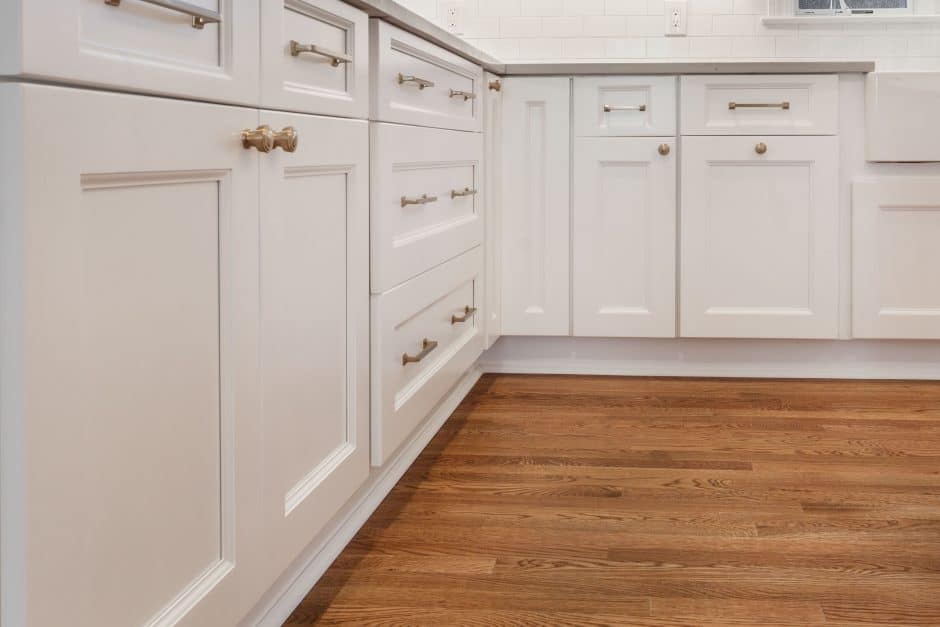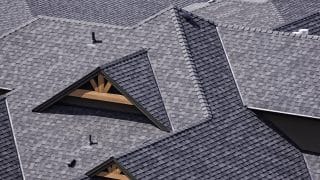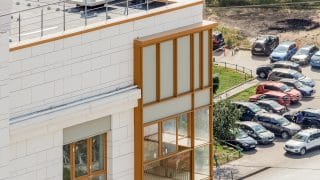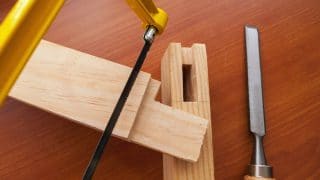
Shaker style is synonymous with clean lines and minimalist design—cornerstones born out of the late 18th century religious movement of the same name in the United States. This group, originally named “The United Society of Believers in Christ’s Second Appearing,” were more commonly known as “Shakers” thanks to their enthusiastic physical response during religious services: picture lots of robust body movements and dancing that was atypical of the time. The Shakers were also intrepid entrepreneurs, collecting money for their self-sufficient utopia by selling furniture and cabinetry. While there is only one remaining Shaker community in the United States, a lasting icon from the religion are Shaker cabinets.
What are Shaker-style cabinets?
A Shaker-style cabinet door is a five-piece door, made of a 4-piece frame (2 stiles and 2 rails) and 1 recessed center flat panel. Traditionally, Shaker-style cabinets were made from solid wood using species of trees native to the Americas, like pine, maple, or birch. Today, shaker cabinets are made using a range of materials, including sustainable wood choices like reclaimed wood and FSC-certified hardwoods.
What are the origins of Shaker cabinets?
To better understand this design style and origin of Shaker cabinets, one has to look at the ethos of Shakers themselves. Shakers believed in honesty, purity, and simplicity as a way of living as close to God as possible. They aimed for utilitarian perfection by applying these tenets to everything in their life—from growing food to making their own tools and furniture.
The ornate decorations popular at the time were considered sinful by the Shakers, that the decorations were hiding or concealing the true nature of what was underneath. Thus, Shaker-style furniture was simple without any decoration, thereby highlighting the beauty of the material and craftsmanship. Rather than use imported wood, which would be costly and perhaps even ostentatious, the Shakers used wood often found on their land. Pine, maple, ash, birch, and cherry were readily available in the eastern United States and allowed them to perfect the designs of their modest yet expertly crafted pieces. The beauty of the wood and the quality of craftsmanship made Shaker-style furniture highly sought-after across the United States.
Types of Shaker-style cabinets
Like all kitchen cabinet doors, Shaker-style kitchen cabinets have three structure door styles and how they relate to the cabinet frames: inset, partial overlay, and full overlay.
Shaker style is synonymous with clean lines and minimalist design—cornerstones born out of the late 18th century religious movement of the same name in the United States. This group, originally named “The United Society of Believers in Christ’s Second Appearing,” were more commonly known as “Shakers” thanks to their enthusiastic physical response during religious services: picture lots of robust body movements and dancing that was atypical of the time. The Shakers were also intrepid entrepreneurs, collecting money for their self-sufficient utopia by selling furniture and cabinetry. While there is only one remaining Shaker community in the United States, a lasting icon from the religion are Shaker cabinets.
What are Shaker-style cabinets?
A Shaker-style cabinet door is a five-piece door, made of a 4-piece frame (2 stiles and 2 rails) and 1 recessed center flat panel. Traditionally, Shaker-style cabinets were made from solid wood using species of trees native to the Americas, like pine, maple, or birch. Today, shaker cabinets are made using a range of materials, including sustainable wood choices like reclaimed wood and FSC-certified hardwoods.
What are the origins of Shaker cabinets?
To better understand this design style and origin of Shaker cabinets, one has to look at the ethos of Shakers themselves. Shakers believed in honesty, purity, and simplicity as a way of living as close to God as possible. They aimed for utilitarian perfection by applying these tenets to everything in their life—from growing food to making their own tools and furniture.
The ornate decorations popular at the time were considered sinful by the Shakers, that the decorations were hiding or concealing the true nature of what was underneath. Thus, Shaker-style furniture was simple without any decoration, thereby highlighting the beauty of the material and craftsmanship. Rather than use imported wood, which would be costly and perhaps even ostentatious, the Shakers used wood often found on their land. Pine, maple, ash, birch, and cherry were readily available in the eastern United States and allowed them to perfect the designs of their modest yet expertly crafted pieces. The beauty of the wood and the quality of craftsmanship made Shaker-style furniture highly sought-after across the United States.
Types of Shaker-style cabinets
Like all kitchen cabinet doors, Shaker-style kitchen cabinets have three structure door styles and how they relate to the cabinet frames: inset, partial overlay, and full overlay.
- Inset: Inset cabinet door frames are set into the cabinet, creating a flush and seamless look. The hinges are either exposed on the outside or hidden on the inside (a more modern Shaker look includes concealed hinges that enhance the minimalist style.) This choice requires hardware to open the doors or a “push to open hinge”—where you need to push on the door to open and close it.
- Partial overlay: Partial overlay style reveals part of the cabinet around the cabinet doors—usually around 2” of the frame is exposed.
- Full overlay: In full overlay style, the doors and drawers extend over the entire cabinet frame—eliminating very little or any cabinet framing from view. Full overlay is typically less expensive than inset cabinet doors but achieves a similar, modern, seamless look as the inset.
What are the benefits of Shaker cabinets?
Choosing Shaker cabinet doors for a kitchen is a timeless design choice that can be customized easily and inexpensively thanks to paint, stains, and hardware choices.
- A range of wood choices. Traditionally, Shaker cabinets are made using solid hardwoods, like pine, birch, or maple. If solid wood is too expensive, there have also been innovations with alternative wood choices like MDF and plywood that can help achieve the look without the additional cost of high-quality solid wood.
- Match many design styles. Regardless of your style choices, today’s Shaker cabinets are versatile enough to work well in a broad spectrum of designs—from both traditional to modern kitchens. So whether you would like white Shaker kitchen cabinets to make the space feel bright and airy, want to try the dramatic look of a two-tone kitchen where the base cabinets are a darker color while the upper cabinets are a lighter one, or even try something moody with a dark mahogany stain, the beauty of Shaker-style lies in its diversity and ability to complement a range of design preferences.
- More affordable than other cabinet choices. Due to the simple design of Shaker-style cabinets, which have no ornamentation and are made with a 5-piece door, Shaker cabinets are typically more affordable than other types of cabinets (like Louvered cabinets).
What is the difference between Shaker cabinets and Mission cabinets?
Shaker-style cabinets are distinctive, and while some may confuse them with Mission-style—since they both tend to be made of a flat panel or a recessed center panel with trim—there are notable differences.
- Mission cabinets, made primarily from oak, are rarely painted and might only be stained to protect the wood from moisture. The natural wood grain is a distinctive part of the Mission style.
- Shaker cabinets, on the other hand, are more customizable depending on the vision for the space.
- Shaker cabinets feature wood pulls whereas Mission style cabinets typically have heavier, more ornate hardware.
MT Copeland offers video-based online classes that give you a foundation in construction fundamentals with real-world applications, like how to build shaker cabinets. Classes include professionally produced videos taught by practicing craftspeople, and supplementary downloads like quizzes, blueprints, and other materials to help you master the skills.







